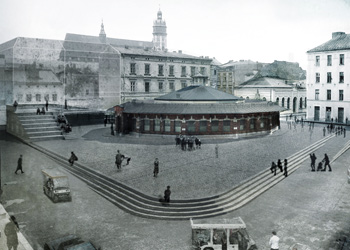A New Plac Nowy
Plac Nowy in Kazimierz can expect a facelift next year that will take it back (almost) to its 1930s incarnation. Or so the design that won the competition for the redevelopment of the square indicates. It belongs to Lewicki-Łatak, a well-known Krakow architectural studio, whose austere vision was judged as best preserving the atmosphere of the place while allowing it to fulfil many functions. Their reward is a 20,000-złoty cheque and an invitation to negotiate the contract for detailed design and supervision of the two million złoty refurbishment.
The power of public markets to contribute positively to a city’s image has long been understood as part of the long urban tradition in Europe. For centuries, local governments have established market laws and constructed special buildings and spaces that protected citizens from spoiled food, high prices, food shortages, and being cheated. Markets also have the reputation for being the place where visitors can observe the entire city in miniature, so designing a new one that comes alive rather than stays a sterile public space, is a tricky architectural challenge. The Plac Nowy competition received 24 submissions (including entries from Spain, Italy and the UK), each with a different interpretation of the brief, ranging from a system of covered market stalls radiating from the centre, to a series of clouds floating over the space. Apart from the winner, the jury awarded three honourable mentions, all of them to Krakow architects. Andrzej Wyżykowski, the chief Krakow architect and a juror, stated that the foreign architects completely missed the character of the place.
Lewicki-Łatak are already responsible for a number of prominent public spaces in Krakow, including the Princes Czartoryski Square next to the Floriańska Gate, the eerie Bohaterów Getta Square in Podgórze and the contemporary Hotel Pod Wawelem. Their vision for Plac Nowy is notable for its sparseness: the main feature is an elevated platform on the south side of the square, the roof of which will provide a viewing point for the square as well as a stage for the regular concerts that are now held on the roof of the “Okrąglak”. The market administration offices, a storage area, a public toilet and covered space for market stalls will be housed underneath the platform while steps leading up to the roof will also provide seating for pedestrians and audiences. The rest of the square is cleared to provide an open space and the worn, 90-year-old concrete surface of the square will be removed, crushed and reused in the construction. The new Plac Nowy will be engraved with images that symbolise its previous influences, such as the businesses and institutions that used to function there, councillors who served to shape its present and the legends and characters that arose in and inhabited its shadows.
Despite the fact that the Lewicki-Łatak team was advised by local art historian Barbara Zbroja, who specialises in 19th and 20th century Jewish history and the architecture of Krakow and Galicia, the Przyjazny Kazimierz local residents’ association, formed in 2007 to fight for a sustainable and inclusive future of the square, have strong reservations about the winning entry. Their two most pressing concerns are that the winning visualisations show no traces of a market on the square, which they see as evidence that the primary and historic function of the square as a fresh food market is going to be further sidelined. Their second concern is that the presence of a stage and free seating will increase the nighttime noise and associated problems that they already struggle with. Lewicki-Łatak stated that these specifics still need to be worked out.
Plac Nowy, also known as the Jewish Square (Plac Żydowski), is part of the old urban landscape of the former city of Kazimierz, which was registered in the list of monuments in the 1930s and became a World Heritage Site. In the early 20th century, the wooden buildings that stood in this place were demolished to create the square we see today. The round building in the centre, known as the “Okrąglak” was built in 1900 and for years it was the ritual poultry slaughter house – you bought your live chickens, ducks or geese on the square, took them to be slaughtered (according to kosher rules if needed), then took them to the ladies who plucked them (their fee was the feathers). Since the 1990s Plac Nowy has become one of the most popular places to hang out in Kazimierz, particularly at night.


Dear sir,
I heard that Mrs. Barbara Zbroja wrote about my grandfather and I want to have a contact with her.
Can you give me her e-mail address?
Sincerely yours,
Varda Gross-Tsur